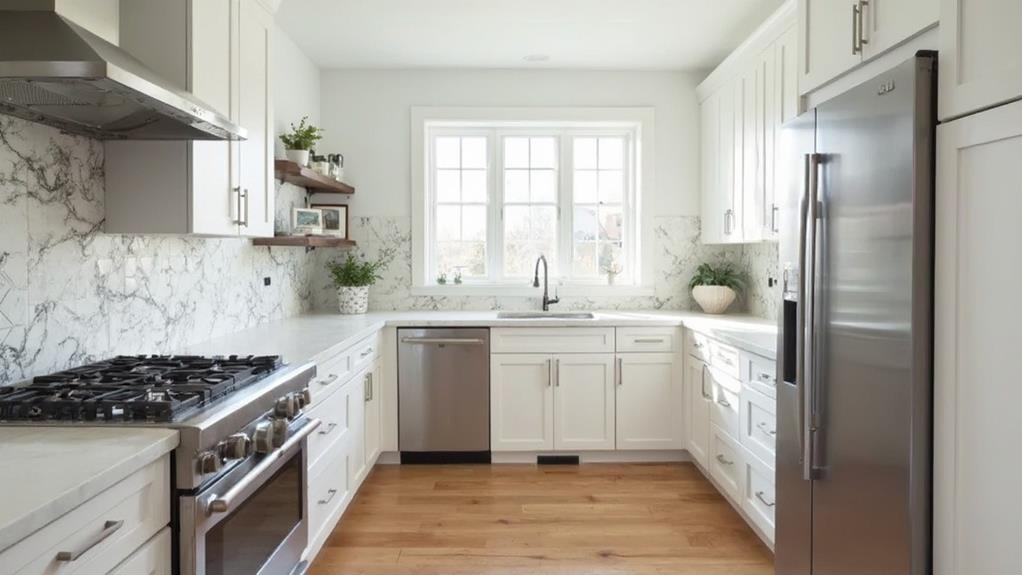Budget-friendly alternatives to high-end renovation materials can transform your home without breaking the bank. Laminate flooring offers durability and style at a fraction of hardwood's cost. Affordable countertop options like laminate, solid surface, or butcher block mimic pricier materials. Faux stone veneer provides the look of natural stone without the expense. Cabinet refacing using thermofoil or laminate refreshes kitchens economically. Peel-and-stick tiles or painted designs create eye-catching backsplashes inexpensively. Updating lighting fixtures through DIY projects or thrifting adds ambiance affordably. These alternatives deliver impressive results while keeping costs down. Exploring these options further reveals a world of possibilities for budget-conscious renovators.
Laminate vs. Hardwood Flooring
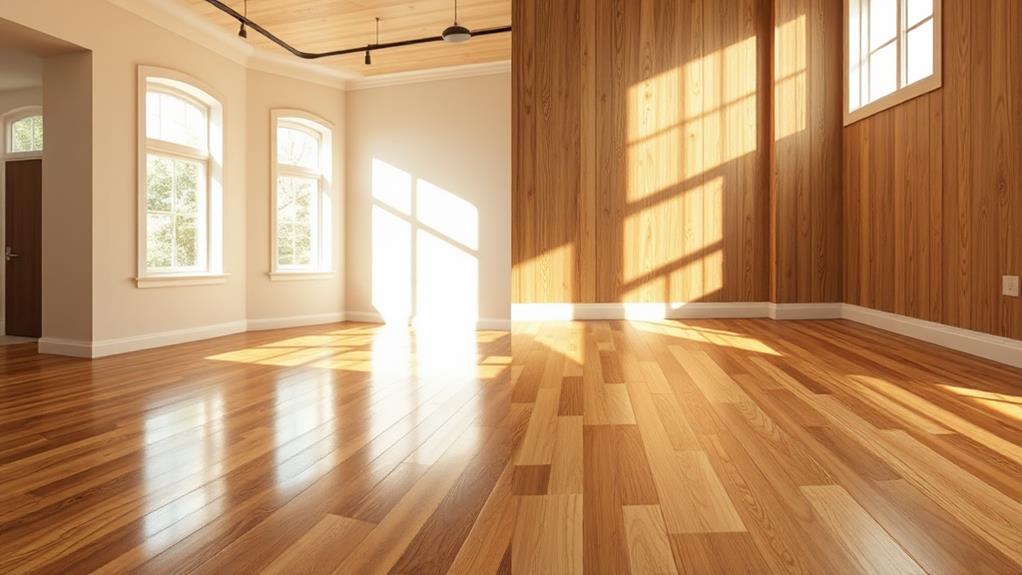
Two of the most popular flooring options for budget-conscious renovators are laminate and hardwood. Laminate flooring offers a cost-effective alternative to genuine hardwood, typically costing 50-70% less per square foot. It consists of a photographic layer that mimics wood grain, sealed beneath a clear protective coating. Laminate is highly durable, resistant to scratches and stains, and easy to clean, making it ideal for high-traffic areas and homes with pets or children.
Hardwood flooring, while more expensive, provides a natural, timeless aesthetic and can increase a home's resale value. It comes in various species, colors, and finishes, allowing for customization to suit different design preferences. Hardwood can be refinished multiple times, extending its lifespan and potentially offsetting its higher initial cost. However, it is more susceptible to scratches, dents, and moisture damage than laminate.
When choosing between laminate and hardwood, consider factors such as budget, room location, maintenance requirements, and long-term plans for the space. Both options offer distinct advantages, and the right choice depends on individual needs and priorities.
Quartz Countertop Alternatives
Moving from flooring to countertops, budget-conscious renovators often seek alternatives to expensive quartz surfaces. While quartz offers durability and aesthetic appeal, several cost-effective options can provide similar benefits at a fraction of the price.
Laminate countertops have come a long way in recent years, offering realistic stone-like appearances and improved durability. High-quality laminate can mimic the look of quartz while being significantly more affordable.
Solid surface countertops, made from acrylic and polyester blends, provide a seamless, non-porous surface that resists stains and is easy to maintain. They come in various colors and patterns, including those that resemble natural stone.
For those seeking a natural material, butcher block countertops offer warmth and character at a lower cost than quartz. Properly sealed, they can be durable and long-lasting.
Ceramic tile is another budget-friendly option, available in countless styles and colors. With proper installation and grouting, tile countertops can be both attractive and functional.
Lastly, concrete countertops offer a unique, industrial look and can be customized to suit various design preferences, often at a lower cost than quartz.
Faux Stone Veneer Options
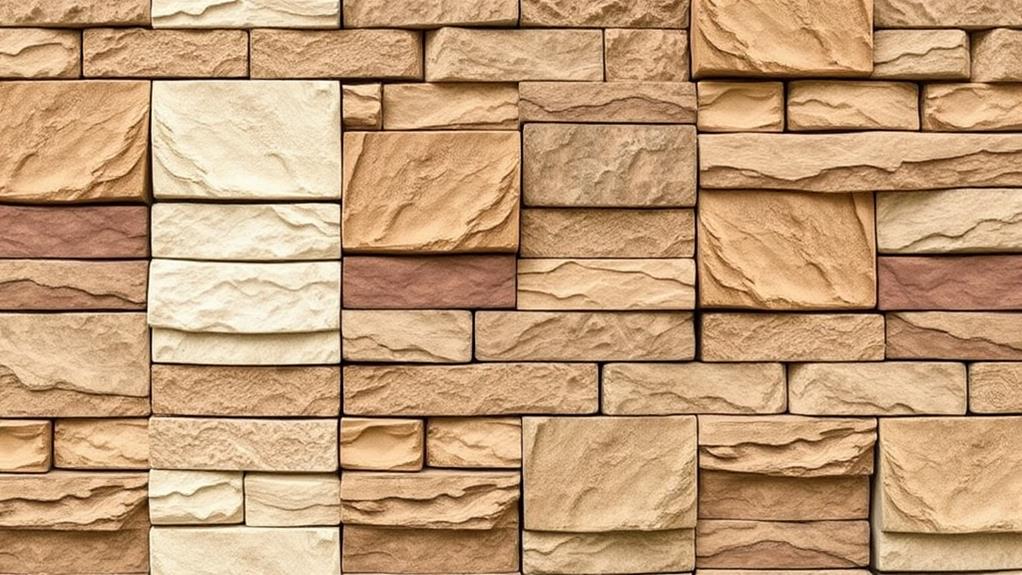
While natural stone can significantly enhance a home's aesthetic appeal, its high cost often makes it prohibitive for budget-conscious renovators. Fortunately, faux stone veneer options provide an affordable alternative that closely mimics the look of genuine stone. These lightweight, synthetic materials are designed to replicate various types of stone, including slate, limestone, and fieldstone.
Manufactured stone veneer is typically made from Portland cement, aggregates, and iron oxides. It's cast in molds taken from real stones, resulting in a remarkably authentic appearance. Polyurethane panels offer another cost-effective option, featuring realistic textures and colors that convincingly imitate natural stone. These panels are easy to install and can be cut with standard woodworking tools.
For exterior applications, fiber cement panels provide a durable, weather-resistant solution that replicates the look of stacked stone or brick. Interior spaces can benefit from peel-and-stick faux stone wallpaper, which offers a quick and simple way to add texture and visual interest to accent walls. When selecting faux stone veneer, consider factors such as durability, maintenance requirements, and installation ease to ensure the best fit for your renovation project and budget.
Affordable Cabinet Refacing Solutions
Cabinet refacing offers a cost-effective alternative to full cabinet replacement, allowing homeowners to transform their kitchen's appearance without breaking the bank. This process involves replacing cabinet doors and drawer fronts while applying a new veneer to the existing cabinet boxes. Affordable materials for refacing include thermofoil, laminate, and wood veneer.
Thermofoil, a vinyl material heat-sealed to engineered wood, provides a durable and easy-to-clean surface at a lower cost than solid wood. Laminate offers a wide range of colors and patterns, mimicking the look of more expensive materials like wood or stone. Wood veneer, though pricier than the other options, still costs less than new cabinets and provides an authentic wood appearance.
DIY-friendly peel-and-stick veneers have gained popularity for their ease of application and low cost. These self-adhesive sheets come in various finishes and can be easily trimmed to fit cabinet surfaces. For those seeking a more dramatic change, paint-grade materials allow homeowners to refresh their cabinets with a new color using specialized cabinet paint, creating a custom look at a fraction of the cost of new cabinetry.
Budget-Friendly Backsplash Ideas
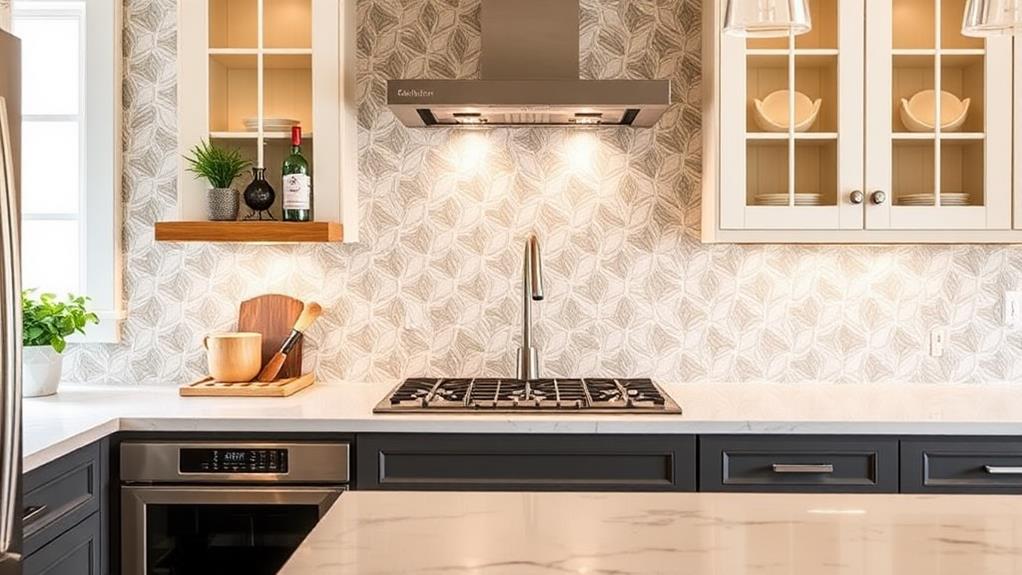
For homeowners looking to upgrade their kitchen or bathroom on a budget, affordable backsplash options can provide a significant visual impact without the hefty price tag. Several cost-effective materials can transform these spaces while keeping expenses in check.
Peel-and-stick tiles offer a quick and easy solution, available in various designs and textures that mimic more expensive materials. These adhesive tiles can be applied directly over existing surfaces, reducing installation costs.
Another budget-friendly option is painting the backsplash area with durable, moisture-resistant paint. Stencils can be used to create intricate patterns, adding visual interest.
For a more traditional look, ceramic subway tiles remain a popular and affordable choice. Their classic appearance suits various design styles, and their widespread availability keeps costs down. Alternatively, beadboard paneling provides a charming, cottage-style aesthetic at a fraction of the cost of tile. It can be easily painted to match any color scheme.
Those seeking a modern industrial look might consider corrugated metal sheets or reclaimed wood planks. These materials offer unique textures and can be sealed for water resistance. With creativity and careful planning, homeowners can achieve stunning backsplash designs without breaking the bank.
Inexpensive Lighting Fixture Upgrades
Lighting fixtures play a crucial role in setting the ambiance and functionality of any room, and upgrading them doesn't have to be expensive. There are numerous budget-friendly options available that can transform your space without breaking the bank.
One cost-effective solution is to repurpose existing fixtures by painting them or adding new shades. A fresh coat of spray paint can give an old chandelier or pendant light a modern look, while fabric or paper shades can update table lamps inexpensively. Another option is to explore thrift stores, flea markets, and online marketplaces for second-hand fixtures that can be refurbished or used as-is.
For those seeking new fixtures, consider LED options, which are energy-efficient and long-lasting, potentially saving money in the long run. Many affordable retailers offer stylish LED fixtures at competitive prices. Additionally, installing dimmer switches can enhance the versatility of your lighting without requiring new fixtures.
DIY projects, such as creating mason jar pendant lights or constructing industrial-style pipe lamps, offer unique and budget-friendly alternatives. These projects allow for customization while keeping costs low. Lastly, don't underestimate the power of strategic placement of inexpensive string lights or battery-operated LED puck lights to create ambient lighting in various rooms.
Cost-Effective Window Treatment Choices
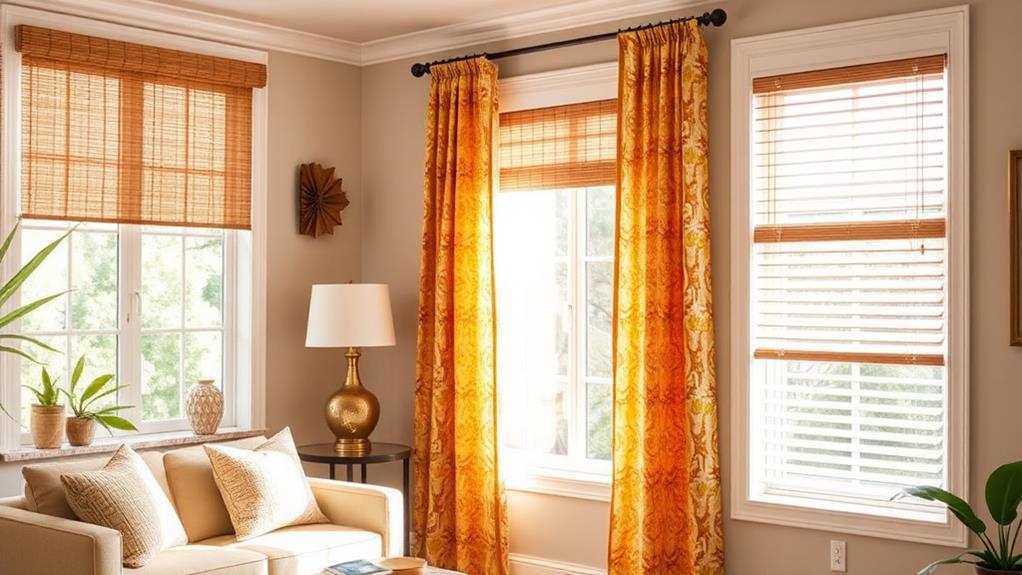
When it comes to window treatments, there are numerous cost-effective options that can enhance both the aesthetics and functionality of your space. Roller shades offer a clean, modern look and are available in various materials and opacities. These affordable window coverings can be easily installed and provide excellent light control.
Venetian blinds, made from aluminum or faux wood, are another budget-friendly choice. They offer versatility in light control and privacy while remaining durable and easy to clean. For a softer appearance, consider fabric roman shades, which can be DIY-ed using inexpensive materials like drop cloths or bedsheets.
Curtains made from affordable fabrics like cotton or polyester blends can dramatically transform a room. Look for ready-made panels or sew your own for additional savings. Bamboo or woven wood shades add texture and natural warmth to a space at a fraction of the cost of custom window treatments.
For added insulation without breaking the bank, thermal curtains or cellular shades can help reduce energy costs. These options not only provide privacy but also improve your home's energy efficiency, making them a smart investment for budget-conscious homeowners.
Economical Bathroom Renovation Materials
Bathroom renovations can be accomplished on a budget with careful material selection. For flooring, consider luxury vinyl tiles (LVT) or sheet vinyl, which mimic the look of more expensive materials like ceramic or stone at a fraction of the cost. Porcelain tiles are another durable and cost-effective option for both floors and walls.
When updating vanities, opt for ready-to-assemble (RTA) cabinets or refurbish existing ones with paint and new hardware. For countertops, laminate offers an affordable alternative to natural stone, while solid surface materials provide durability at a moderate price point. Choose a standard-sized, prefabricated shower unit or tub surround to avoid costly custom installations.
For fixtures, focus on water-efficient models, which save money in the long run. Consider chrome finishes, which are typically less expensive than brushed nickel or oil-rubbed bronze. LED lighting fixtures offer energy savings and longevity. When selecting a toilet, choose a basic two-piece model rather than pricier one-piece designs. Finally, refresh the look of existing tiles with grout renewing products instead of complete replacement, significantly reducing labor and material costs.
Outdoor Living Space Savings
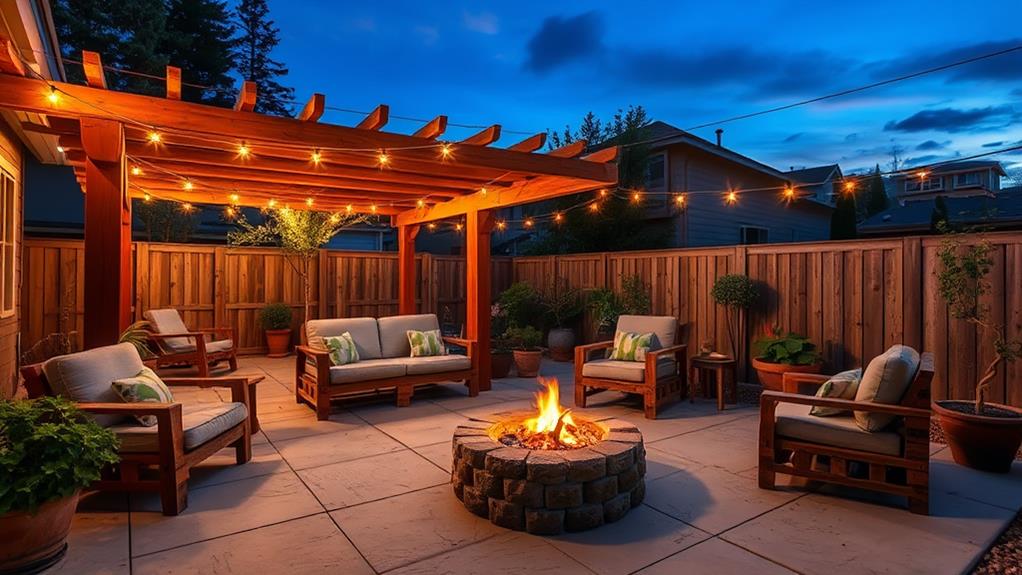
Creating an outdoor living space doesn't have to break the bank. With careful planning and smart material choices, you can transform your backyard into a functional and attractive area without overspending. Consider using gravel or crushed stone instead of expensive pavers for pathways and seating areas. These materials are cost-effective and provide good drainage.
For decking, opt for pressure-treated lumber or composite materials instead of high-end hardwoods. These alternatives offer durability and low maintenance at a fraction of the cost. When it comes to furniture, look for end-of-season sales or consider DIY options using pallets or repurposed materials.
Incorporate affordable landscaping elements like native plants, which require less maintenance and water. Use mulch to define planting areas and retain moisture, reducing the need for frequent watering. For lighting, solar-powered options eliminate the need for electrical work and save on energy costs.
Create privacy with fast-growing plants or bamboo screens instead of costly fencing. Finally, consider a simple fire pit made from concrete blocks or a portable chiminea as an alternative to expensive built-in fireplaces.
Frequently Asked Questions
How Can I Estimate the Overall Cost Savings of Using Budget-Friendly Alternatives?
To estimate overall cost savings of budget-friendly alternatives, compare prices of high-end and budget options for each material. Calculate the difference per unit or square foot, then multiply by the total quantity needed for your project.
Are There Any Eco-Friendly Options Among These Budget-Friendly Renovation Materials?
In an overwhelmingly green revolution, eco-friendly options abound among budget-conscious renovation materials. Recycled glass countertops, bamboo flooring, reclaimed wood, low-VOC paints, and energy-efficient appliances offer sustainable alternatives that are both wallet-friendly and environmentally responsible for conscientious homeowners.
Do Budget Alternatives Affect a Home's Resale Value Compared to High-End Materials?
Budget alternatives can potentially impact a home's resale value compared to high-end materials. However, the effect varies depending on the specific renovation, market trends, and buyer preferences. Skillful application and overall aesthetic can often mitigate any negative impact.
How Long Do Budget-Friendly Materials Typically Last Compared to Their Expensive Counterparts?
As the crow flies, budget-friendly materials often have shorter lifespans than their expensive counterparts. Typically, they last 5-15 years compared to 15-30 years for high-end options. However, proper maintenance can extend their durability significantly.
Can I Mix High-End and Budget-Friendly Materials in the Same Renovation Project?
Absolutely, you can mix high-end and budget-friendly materials in a renovation project. This approach, known as high-low design, allows for strategic splurging on key elements while economizing on others, resulting in a balanced and stylish outcome.
Conclusion
Budget-friendly renovation alternatives offer homeowners the opportunity to achieve high-end aesthetics without exorbitant costs. By selecting cost-effective materials and employing creative solutions, significant savings can be realized across various home improvement projects. Interestingly, a recent study by the National Association of Home Builders found that 58% of homeowners prioritize cost-effectiveness over luxury in their renovation choices. This trend underscores the growing demand for affordable yet stylish alternatives in the home improvement market, driving innovation in budget-friendly materials and techniques.
